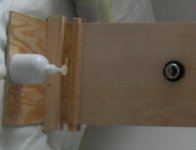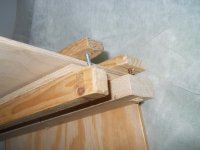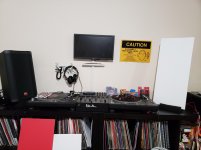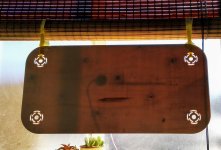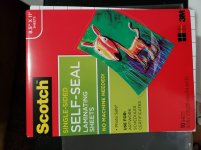@Twocents Still love the sound of the XPS panels and I will continue to experiment with it, it's just difficult to make them attractive.

Why the unhappy emoticon look at the bottom? Is it something to do with the sound?
My thinking behind that was because I used some silicone to support the panel on the stand below the cut, the cut would allow the panel to move more freely if that makes any sense.
Here's a horrible demo video if anyone is interested.
[/url]
Is the bass coming from the panels?
How about a video (or an audio file) without the bass? The singer's voice was very clear.No the panels are only from about 120hz
Here's a pic of my newest test panels, I'll be posting a Instructable on them in the next few days. They were intended as mid/high drivers to accompany my 4in bookshelf speakers.
They are 29cm X 25cm 3mm birch ply
PLA+ 3d printed whizzer cones
teax25 exciters
Those are cool. Also in for details.
Tallboy - My version inspired by BurntCoil
I have done two versions of Burntcoils panels - one with 25 w 4 ohm Dayton speakers and the last with 40w 8ohm. My experience is that the 40 w exciters are better in frequency and range down to about 40 HZ. But the panels need to be mounted on a solid "base" fundament to avoid buzzing noise from the panel. I have as you see in the pictures a fundament to fix the panels and i have a big stone - 5kg - standing on the bottom to avoid bass trembling....
Allan
I have done two versions of Burntcoils panels - one with 25 w 4 ohm Dayton speakers and the last with 40w 8ohm. My experience is that the 40 w exciters are better in frequency and range down to about 40 HZ. But the panels need to be mounted on a solid "base" fundament to avoid buzzing noise from the panel. I have as you see in the pictures a fundament to fix the panels and i have a big stone - 5kg - standing on the bottom to avoid bass trembling....
Allan
Attachments
Messed around a bit today. Tried some of the layered 2 way designs I was brainstorming and they didn't pan out. Putting a smaller HF panel in front of a LF panel didn't block much low end but the reinforcement of the HFs from the reflection off the LF panel behind it muddied the noise and bumped midrange frequencies in an unsavory way. If I increased separation between the two panels it sounded much better but it was an impractical distance - like at least a foot. If I trimmed the HF panels so narrow as to reduce the replections and LF blockage even more the panel became too small and both SPL and FR suffered. So that's a no-go.
I tried a couple of biamplified/biexcited single panels in an L/R comparison with one of my PA speakers and I got some interesting results. I kept the surface dimensions approximately the same as the H/W on the PA speaker for "fairness". I was only able to single amplify the PA cab so I fed it the high pass signal that I was sending to the small exciter on the competing panel, crossed over at 250Hz, 12dB slope. The panels were wedged into a foam base, so only slightly damped on the bottom edge. Music was an assortment of electronic and dance.
The triple walled cardboard panel sounded pretty good but the output was probably 2-3db lower and the midrange lacked the same presence. It also needed some serious damping, as the panel was vibrating excessively.
1/2" EPS brought the SPL basically identical to the speaker, and the midrange quality were very similar, with the panel matching in clarity and presence but trading a ltiny bit of impact for a slightly more open sound. If the crispness of the EPS on the high hats had been able to match the tweeter on the PA it would have been a very dead heat. The panel just couldn't get that crispness and clarity of a separate dome tweeter. That may change when the panel is properly prepped rather than raw. A little EQ could help too. Midbass clarity was on par between the two but the cone had a little more impact again. If I took the crossover off the PA ran away with it, as there was no way the thruster could come close to the SPL, extension, nor depth that the 10 driver in the PA can achieve. Paired with a small subwoofer the panels would be a much closer competition.
I tried the Birch panel but it was much larger, and while the highs were crisper and the mids smooth the low end suffered and the difference in SPL was massive. Once I get a panel trimmed to scale I think that may give me the best overall FR at the high end but I know SPL will still be notably down and I'm expecting midbass to not be where I want it either, but that will remain to be seen. I will try that and a 1/2" xps panel next.
I tried a couple of biamplified/biexcited single panels in an L/R comparison with one of my PA speakers and I got some interesting results. I kept the surface dimensions approximately the same as the H/W on the PA speaker for "fairness". I was only able to single amplify the PA cab so I fed it the high pass signal that I was sending to the small exciter on the competing panel, crossed over at 250Hz, 12dB slope. The panels were wedged into a foam base, so only slightly damped on the bottom edge. Music was an assortment of electronic and dance.
The triple walled cardboard panel sounded pretty good but the output was probably 2-3db lower and the midrange lacked the same presence. It also needed some serious damping, as the panel was vibrating excessively.
1/2" EPS brought the SPL basically identical to the speaker, and the midrange quality were very similar, with the panel matching in clarity and presence but trading a ltiny bit of impact for a slightly more open sound. If the crispness of the EPS on the high hats had been able to match the tweeter on the PA it would have been a very dead heat. The panel just couldn't get that crispness and clarity of a separate dome tweeter. That may change when the panel is properly prepped rather than raw. A little EQ could help too. Midbass clarity was on par between the two but the cone had a little more impact again. If I took the crossover off the PA ran away with it, as there was no way the thruster could come close to the SPL, extension, nor depth that the 10 driver in the PA can achieve. Paired with a small subwoofer the panels would be a much closer competition.
I tried the Birch panel but it was much larger, and while the highs were crisper and the mids smooth the low end suffered and the difference in SPL was massive. Once I get a panel trimmed to scale I think that may give me the best overall FR at the high end but I know SPL will still be notably down and I'm expecting midbass to not be where I want it either, but that will remain to be seen. I will try that and a 1/2" xps panel next.
Attachments
Tonewood DML Speaker
Hi All,
My Dad and I have spent the last several months R&Ding a speaker similar to the JMC soundboard from Switzerland (to the best of our knowledge it does not appear to have a patent in North America where we're located, please correct me if I'm wrong). We have no plans to mass manufacture or anything, just wanted to try it and see what we could learn.
We've borrowed a number of the JMC's design elements, but are making some significant alterations to the case design. We're also replacing its passive crossover system with a fully digital one (MiniDSP 4x10) and augmenting output of lower frequencies with a sub.
We're very happy with the prototype, which is a few weeks away from being finished. We still need to finish design and construction of the backing, exciter spines, and cabling infrastructure (below pictured cabling is temporary). I've been doing some tests with enclosure-like wall placements (pictured), to see how this affects the sound as we design the cabinet. Most likely it will be placed on an open wall with a sound-controlling cabinet in the final version. We're using spruce tonewood from a Luthier supplier for the soundboard, along with spruce bracewood for the frame.
I've attached a few photos. To me, it sounds "very good". I can't hear anything above 14k, and have little experience with HiFi audio, but I was a professional musician and am an avid music listener. To my ears, it doesn't beat a $3000-5000+ HiFi system, but it's probably able to compete with something in the $500-$2k range. And this is not even to mention the aesthetic / design strengths it has. If to one's tastes, I think it exceeds the appeal of standard tower speakers.
Anyhow, I'm hoping to put up a more complete blog page about what we did soon, but here are some pictures to check out.
Cheers!
Hi All,
My Dad and I have spent the last several months R&Ding a speaker similar to the JMC soundboard from Switzerland (to the best of our knowledge it does not appear to have a patent in North America where we're located, please correct me if I'm wrong). We have no plans to mass manufacture or anything, just wanted to try it and see what we could learn.
We've borrowed a number of the JMC's design elements, but are making some significant alterations to the case design. We're also replacing its passive crossover system with a fully digital one (MiniDSP 4x10) and augmenting output of lower frequencies with a sub.
We're very happy with the prototype, which is a few weeks away from being finished. We still need to finish design and construction of the backing, exciter spines, and cabling infrastructure (below pictured cabling is temporary). I've been doing some tests with enclosure-like wall placements (pictured), to see how this affects the sound as we design the cabinet. Most likely it will be placed on an open wall with a sound-controlling cabinet in the final version. We're using spruce tonewood from a Luthier supplier for the soundboard, along with spruce bracewood for the frame.
I've attached a few photos. To me, it sounds "very good". I can't hear anything above 14k, and have little experience with HiFi audio, but I was a professional musician and am an avid music listener. To my ears, it doesn't beat a $3000-5000+ HiFi system, but it's probably able to compete with something in the $500-$2k range. And this is not even to mention the aesthetic / design strengths it has. If to one's tastes, I think it exceeds the appeal of standard tower speakers.
Anyhow, I'm hoping to put up a more complete blog page about what we did soon, but here are some pictures to check out.
Cheers!
Attachments
-
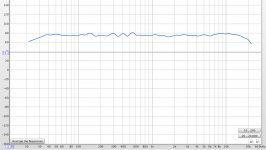 REW.jpg100.1 KB · Views: 351
REW.jpg100.1 KB · Views: 351 -
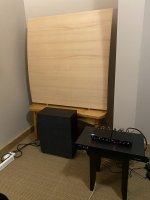 IMG_2882.jpg357.3 KB · Views: 389
IMG_2882.jpg357.3 KB · Views: 389 -
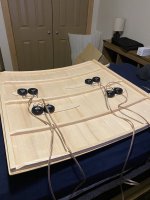 IMG_2876.jpg394.2 KB · Views: 385
IMG_2876.jpg394.2 KB · Views: 385 -
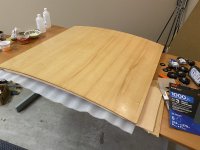 IMG_2912.jpg233.1 KB · Views: 366
IMG_2912.jpg233.1 KB · Views: 366 -
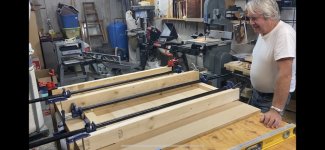 IMG_2917.jpg144.5 KB · Views: 506
IMG_2917.jpg144.5 KB · Views: 506 -
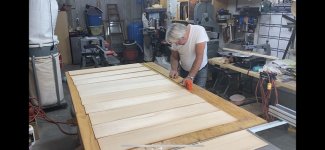 IMG_2918.jpg135.1 KB · Views: 515
IMG_2918.jpg135.1 KB · Views: 515 -
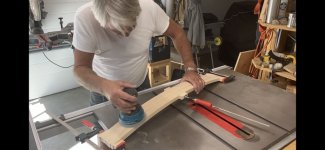 IMG_2919.jpg111.7 KB · Views: 516
IMG_2919.jpg111.7 KB · Views: 516 -
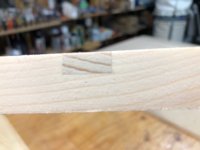 joint.jpg99.8 KB · Views: 501
joint.jpg99.8 KB · Views: 501 -
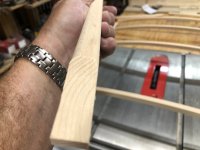 IMG_1967.jpg148.8 KB · Views: 516
IMG_1967.jpg148.8 KB · Views: 516
More tests today. I got some contact paper from Staples and put it on the back of the cardboard and 1/2" eps. I found in my earlier experiments that putting a thin sheet of plastic seemed to sharpen the response of the high end and increase the output slightly. The laminate sheets are thinner but still give the exciters something better to stick to and conduct the vibrations to the substrate. The sheets stuck well to the cardboard but I had to put down a layer of industrial strength spray adhesive to get it to stick to the eps. I also used some metal 1/2" J Trim to reinforce/dampen the edges of the eps so it wouldn't flex so much. I put one on the left and the other on the right.
With electronic music the eps still had the advantage, although the output between the two was far more even now. The eps loses a little sensitivity but gains crispness and a little high end extension. Hi hats were still muddy compared to the PA speakers, as was the thickness in the midbass.
Then I put on Tori Amos' "Boys for Pele" album. The cardboard really stole the show with this kind of music. The harpsichord, pianos, chimes and strings had a nice clean sound and a sexy resonance and presence to them. The EPS sounded boxy and muffled in the vocals, and too airy everywhere else, with the instruments sinking into the mix. I think the eps is still too flexible and the exciters would benefit slightly from back bracing so I may try that.
I really need to trim up the Birch. I think that's really going to shine everywhere but the low end.
With electronic music the eps still had the advantage, although the output between the two was far more even now. The eps loses a little sensitivity but gains crispness and a little high end extension. Hi hats were still muddy compared to the PA speakers, as was the thickness in the midbass.
Then I put on Tori Amos' "Boys for Pele" album. The cardboard really stole the show with this kind of music. The harpsichord, pianos, chimes and strings had a nice clean sound and a sexy resonance and presence to them. The EPS sounded boxy and muffled in the vocals, and too airy everywhere else, with the instruments sinking into the mix. I think the eps is still too flexible and the exciters would benefit slightly from back bracing so I may try that.
I really need to trim up the Birch. I think that's really going to shine everywhere but the low end.
Attachments
Great to see another set of Tall Blondes Allan, but you have not told us anything about your listening impressions. Good idea to weigh down the base. Thanks for posting.I have done two versions of Burntcoils panels - one with 25 w 4 ohm Dayton speakers and the last with 40w 8ohm. My experience is that the 40 w exciters are better in frequency and range down to about 40 HZ. But the panels need to be mounted on a solid "base" fundament to avoid buzzing noise from the panel. I have as you see in the pictures a fundament to fix the panels and i have a big stone - 5kg - standing on the bottom to avoid bass trembling....
Allan
Impressive build! But it looks like a mono panel? Is there any stereo imaging with such a single panel?Hi All,
My Dad and I have spent the last several months R&Ding a speaker similar to the JMC soundboard from Switzerland
Interesting that they (JMC) use tonewood. Not many woods in the world has that property, but I am not convinced that DML panels made from tonewood are necessarily better for a full range speaker application. They might excel in a certain frequency range or give a warmer ambience. Please share if you have more info on this. Thanks.
Tonewood DML Speaker
Good question! First a quick explanation of the setup: the exciters are configured so that each side, i.e. one long/short bridge pair (running the direction of the length of the bridges, on the same side of a spline) is a crossed-over high/low channel. So the short bridge plays highs, and the long bridge lows. One amp runs the highs, one the lows, and then there's an active sub CX'd at ~200hz as well.
So there is a stereo signal, but how well this translates to a stereo image to listener is something I need to study and compare more. It's definitely not what you'd get in a pair of standard speakers placed 3 meters apart, that's for sure.
I did run some experiments with two XPS foam panels, in single and multiple exciter configurations, and with and without lows crossed over to an external sub. I was not able to A/B them side by side with the soundboard, though.
Both sound good. I'm not sure I could say the tonewood sounds "better". (BTW, the tonewood in question is Luthier grade spruce from British Columbia, purchased from a tonewood supplier, for what that's worth).
I think the main appeal with the soundboard is its overall design aesthetic, the craftsmanship required, and the quality of the wood. These are pretty difficult to build, I think it took us something in the neighbourhood of 80 hours. While the next one would be faster, there is a large amount of very careful work and knowledge that's involved in getting it right. It's a very beautiful piece when installed, especially in the right setting. I think the quality of the materials and work involved adds quite a bit to the overall vibe.
In addition to this, it does sound very, very good--better than I think most people would ever expect from a piece of wood on the wall, and I think better than a high end bluetooth speaker that has similar stereo imaging limitations, maybe even something like a Beoplay A6. It's about 90cm square, slightly higher than it is wide, and I find the image that does emerge is actually quite spacious.
So to answer the question in a roundabout way, I think a piece like this occupies a niche for those who want a particular aesthetic and good sound over just good sound. There are definitely far cheaper and easier ways to get decent sound! But I like a mixture of design and functionality, and much to my surprise, this project totally accomplished that.
Good question! First a quick explanation of the setup: the exciters are configured so that each side, i.e. one long/short bridge pair (running the direction of the length of the bridges, on the same side of a spline) is a crossed-over high/low channel. So the short bridge plays highs, and the long bridge lows. One amp runs the highs, one the lows, and then there's an active sub CX'd at ~200hz as well.
So there is a stereo signal, but how well this translates to a stereo image to listener is something I need to study and compare more. It's definitely not what you'd get in a pair of standard speakers placed 3 meters apart, that's for sure.
I did run some experiments with two XPS foam panels, in single and multiple exciter configurations, and with and without lows crossed over to an external sub. I was not able to A/B them side by side with the soundboard, though.
Both sound good. I'm not sure I could say the tonewood sounds "better". (BTW, the tonewood in question is Luthier grade spruce from British Columbia, purchased from a tonewood supplier, for what that's worth).
I think the main appeal with the soundboard is its overall design aesthetic, the craftsmanship required, and the quality of the wood. These are pretty difficult to build, I think it took us something in the neighbourhood of 80 hours. While the next one would be faster, there is a large amount of very careful work and knowledge that's involved in getting it right. It's a very beautiful piece when installed, especially in the right setting. I think the quality of the materials and work involved adds quite a bit to the overall vibe.
In addition to this, it does sound very, very good--better than I think most people would ever expect from a piece of wood on the wall, and I think better than a high end bluetooth speaker that has similar stereo imaging limitations, maybe even something like a Beoplay A6. It's about 90cm square, slightly higher than it is wide, and I find the image that does emerge is actually quite spacious.
So to answer the question in a roundabout way, I think a piece like this occupies a niche for those who want a particular aesthetic and good sound over just good sound. There are definitely far cheaper and easier ways to get decent sound! But I like a mixture of design and functionality, and much to my surprise, this project totally accomplished that.
Is that one speaker of two together?
Just the one in this case! See my other reply for more details.
Someone asked me once, if I can find the video with the dug out center of the EPS board DML to attach it here. Here it is.
Also, here is a composer playing wooden DMLs.
Also, here is a composer playing wooden DMLs.
Last edited:
- Home
- Loudspeakers
- Full Range
- A Study of DMLs as a Full Range Speaker

